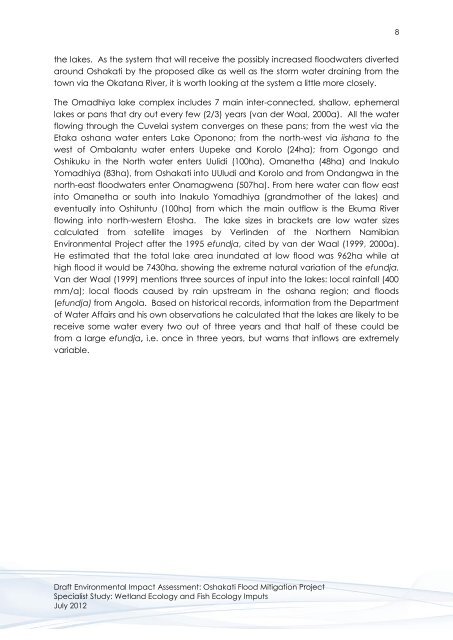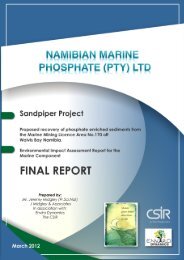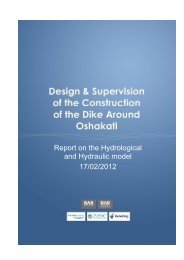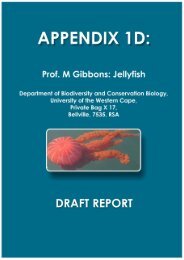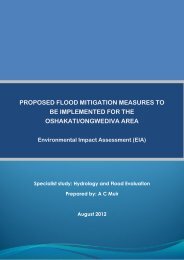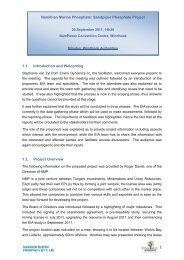Wetland & Fish Ecology - Enviro Dynamics Namibia
Wetland & Fish Ecology - Enviro Dynamics Namibia
Wetland & Fish Ecology - Enviro Dynamics Namibia
You also want an ePaper? Increase the reach of your titles
YUMPU automatically turns print PDFs into web optimized ePapers that Google loves.
8<br />
the lakes. As the system that will receive the possibly increased floodwaters diverted<br />
around Oshakati by the proposed dike as well as the storm water draining from the<br />
town via the Okatana River, it is worth looking at the system a little more closely.<br />
The Omadhiya lake complex includes 7 main inter-connected, shallow, ephemeral<br />
lakes or pans that dry out every few (2/3) years (van der Waal, 2000a). All the water<br />
flowing through the Cuvelai system converges on these pans; from the west via the<br />
Etaka oshana water enters Lake Oponono; from the north-west via iishana to the<br />
west of Ombalantu water enters Uupeke and Korolo (24ha); from Ogongo and<br />
Oshikuku in the North water enters Uulidi (100ha), Omanetha (48ha) and Inakulo<br />
Yomadhiya (83ha), from Oshakati into UUludi and Korolo and from Ondangwa in the<br />
north-east floodwaters enter Onamagwena (507ha). From here water can flow east<br />
into Omanetha or south into Inakulo Yomadhiya (grandmother of the lakes) and<br />
eventually into Oshituntu (100ha) from which the main outflow is the Ekuma River<br />
flowing into north-western Etosha. The lake sizes in brackets are low water sizes<br />
calculated from satellite images by Verlinden of the Northern <strong>Namibia</strong>n<br />
<strong>Enviro</strong>nmental Project after the 1995 efundja, cited by van der Waal (1999, 2000a).<br />
He estimated that the total lake area inundated at low flood was 962ha while at<br />
high flood it would be 7430ha, showing the extreme natural variation of the efundja.<br />
Van der Waal (1999) mentions three sources of input into the lakes: local rainfall (400<br />
mm/a); local floods caused by rain upstream in the oshana region; and floods<br />
(efundja) from Angola. Based on historical records, information from the Department<br />
of Water Affairs and his own observations he calculated that the lakes are likely to be<br />
receive some water every two out of three years and that half of these could be<br />
from a large efundja, i.e. once in three years, but warns that inflows are extremely<br />
variable.<br />
Draft <strong>Enviro</strong>nmental Impact Assessment: Oshakati Flood Mitigation Project<br />
Specialist Study: <strong>Wetland</strong> <strong>Ecology</strong> and <strong>Fish</strong> <strong>Ecology</strong> Imputs<br />
July 2012


